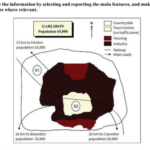The diagrams show how house designs differ according to climate.
The most noticeable difference between houses designed for cool and warm climates is in
the shape of the roof. The designs also differ with regard to the windows and the use of
insulation.
We can see that the cool climate house has a high-angled roof, which allows sunlight to
enter through the window. By contrast, the roof of the warm climate house has a peak in
the middle and roof overhangs to shade the windows. Insulation and thermal building
materials are used in cool climates to reduce heat loss, whereas insulation and reflective
materials are used to keep the heat out in warm climates.
Finally, the cool climate house has one window which faces the direction of the sun, while
the warm climate house has windows on two sides which are shaded from the sun. By
opening the two windows at night, the house designed for warm climates can be ventilated.
(162 words)
Step 1: Band Score Analysis
Estimated Band Score: 8.0
| Criteria | Score | Comments |
|---|---|---|
| Task Achievement | 8.0 | All key features of both diagrams are compared clearly and relevantly. |
| Coherence & Cohesion | 8.0 | Logical flow; clear use of linking devices (“by contrast,” “finally”). |
| Lexical Resource | 8.0 | Very good range of vocabulary; a few opportunities for even higher-level synonyms exist. |
| Grammatical Range & Accuracy | 8.0 | Very good; a mix of simple and complex sentences, no significant errors. |
Band 7–8
The diagrams illustrate the differences in house designs adapted for cool and warm climates.
The most notable distinction between the two is the shape of the roof. In cooler regions, houses feature a steeply sloped roof that enables sunlight to penetrate through the window. In contrast, houses in warmer climates have a roof with a central peak and wide overhangs that provide shade and reduce heat from entering.
Insulation is a key component in both designs but serves different purposes. In cool climates, thermal building materials and insulation help to retain heat inside, while in warm climates, reflective materials and insulation are used to minimize heat absorption.
Finally, while the cool climate house has a single window positioned toward the sun to maximize solar gain, the warm climate house incorporates two windows on opposite sides, allowing for cross-ventilation when opened at night.
Word count: 160
Band 9
The diagrams compare how house designs are adapted to suit cool and warm climates.
The most striking difference lies in the structure of the roof. In cool climates, the house is built with a steep, high-angled roof to allow maximum sunlight penetration through a single window. Conversely, the warm climate house features a roof with a central peak and extended overhangs, which provide shade and limit direct sunlight exposure.
Both designs employ insulation, but for opposite effects. In cool climates, insulation and thermal materials help to conserve heat, whereas in warm climates, reflective materials and insulation are used to deflect heat and keep interiors cool.
Window placement also varies. The cool climate house has one sun-facing window to maximize heat gain, while the warm climate house has windows on two sides, facilitating night-time ventilation through cross-breezes.
Word count: 155
Comparison Table
| Aspect | Band 7–8 Version | Band 9 Version |
|---|---|---|
| Vocabulary | Good range | Excellent precision and range |
| Structure | Clear | Highly polished and sophisticated |
| Data Coverage | Thorough | Thorough and concise |
| Cohesion | Good linking | Seamless linking |
Sentence Comparisons
| Original | Improved |
|---|---|
| “The most noticeable difference between houses…” | “The most striking difference lies in the structure of the roof.” |
| “Finally, the cool climate house has one window…” | “Window placement also varies.” |
| “By contrast, the roof of the warm climate house has a peak…” | “Conversely, the warm climate house features a roof with a peak…” |
Grammar and Spelling Mistakes
This essay was very clean! No real grammar mistakes.
However, a slight style improvement:
- Instead of “to reduce heat loss,” → “to retain heat” sounds stronger.
- Instead of “keep the heat out,” → “deflect heat” adds higher precision.
Vocabulary Repetition
| Repeated Word | Suggested Alternatives |
|---|---|
| “sunlight” | solar energy, sun exposure |
| “window(s)” | openings, glazed sections (only if needed) |
| “materials” | components, substances |
IELTS Writing Task 1 Exercises with Answers
Fill in the blanks using the words: (overhangs, ventilation, insulation, reflective, angled, cross-breezes)
- The roof in the warm climate house has wide __________ to provide shade.
→ overhangs - In cool climates, __________ materials help to keep the heat inside.
→ insulation - The roof in the cool climate house is steeply __________.
→ angled - Houses in warm climates use __________ materials to deflect heat.
→ reflective - Two windows allow __________ at night for cooling.
→ ventilation or cross-breezes (both acceptable)


